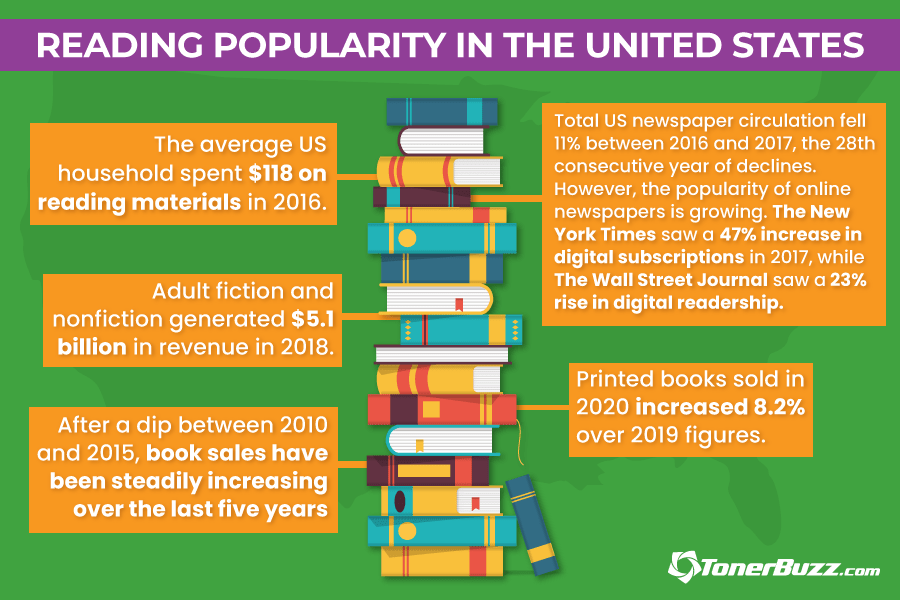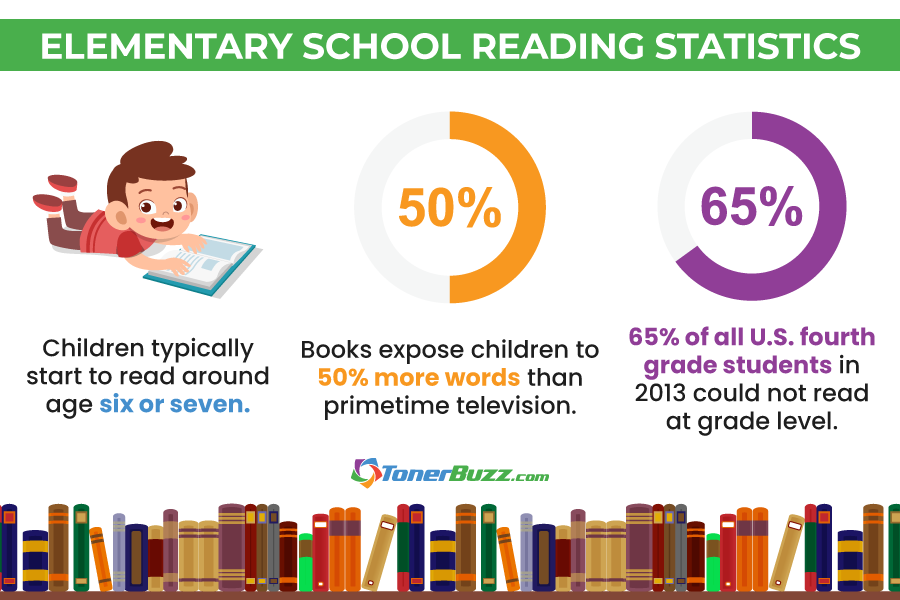How Many Americans Read a Book in the Last Year
While many people and businesses suffered in 2020, book publishers only experienced a minor dip, and really showed gains in many areas. Beingness quarantined indoors had people looking to the old stand-by — books — for a mode to vanquish fearfulness and boredom.
Readers stepped upward in 2020, with avid readers significantly increasing their literary intake. The latest book and reading statistics show how the industry is rebounding afterward a turbulent year.
Global Book Stats 2022
The biggest worldwide players in the field of publishing include the China South Publishing and Media Group, Grupo Planeta, Bertelsmann, Pearson PLC, and Hachette Livre.
Asia and North America are the leaders when it comes to production, with both holding a 34% share of the publishing industry.
- The global book market place is expected to abound from $87.92 billion in 2020 to $92.68 billion in 2021. (BusinessWire)
- By 2025 this number is expected to attain $124.2 billion (GrandView Enquiry)
- A global boilerplate of 16.44 Euro is spent per capita on print and audiobooks. (Statista)
- $12.32 billion was generated through global eBook publishing. (Statista)
- The publishing industry employs 315,731 people effectually the world. (IbisWorld)
- There are already approximately i.5 million new titles published globally in 2021. (Worldometers)
- The 2022 global book market is valued at $150 billion. (Publishdrive)
- Ebook and audiobook sales increased by more than than xxx% since 2020. (Publishdrive) Households with incomes of $75,000 and higher up read more than than households with incomes of less than $30,000. (PewResearch)
U.s. Volume Statistics 2022
Educational demands by K-12 students drove significant increases in book sales. The biggest gains were driven past immature readers and perplexed virtual grade school students looking for additional reference materials.
Adult fiction and nonfiction showed modest increases of 6% and 4.8%, respectively.
Juvenile nonfiction rose 23.i% while juvenile fiction — which targets third-grade and quaternary-grade readers — jumped xi%.
Centre school students and loftier school were behind the biggest gains. Immature developed nonfiction jumped 38.three% as students sought academic back up for online courses. Likewise, young adult fiction jumped 21.four%, revealing that at least a few kids filled their lockdown time past reading.
2020 Sales Increase in All Categories
- Adult fiction: upwardly six%
- Adult nonfiction: up 4/8%
- Juvenile fiction: up 11%
- Juvenile nonfiction: up 23.1%
- Young adult fiction: upwards 21.4%
- Young adult nonfiction: up 38.3%
(Source: Publisher's Weekly)
Americans at domicile with books
- The U.South. book industry generated over $25 billion in 2019. (Statista)
- 693.vii one thousand thousand physical books were sold in the United states of america in 2019. (Statista)
- 700,000 to i,000,000 new titles appear every yr. However, half of these are cocky-published and only sell a handful of copies. (Statista)
- fifty% of all published books are related to pedagogy and scientific discipline. (Statista)
- 751 meg physical books were sold in the U.s. in 2020. (Publisher's Weekly)
- Printed books sold in 2020 increased 8.2% over 2019 figures. (Publisher's Weekly)
- After a dip between 2010 and 2015, sales take steadily increased over the last five years. (Statista)
- Approximately ii,600 different companies make up the U.S. publishing industry. (Grand View Research)
- The U.S. volume marketplace is expected to generate $30 billion by 2025. (G View Enquiry)
➜ READ ALSO:Paper Books vs eBooks
2022 Reading Statistics: A Banner Year For Readers
Information and statistics provided past researchers at Pew Inquiry and Publisher's Weekly ostend that people are reading more than ever.
But that doesn't hateful more people were reading.
It ways people who were already readers read more in 2020.
Why did people read more in 2020?
One of the prime reasons was the rise of homeschooling.
Parents needed to read to children, from lath books for pre-readers to content for first readers attempting to sound out words. With school libraries on lockdown, caregivers searched online for what they needed to promote literacy skills in their children.
But there are other factors to consider when looking at the 2020 book market. People simply had more gratuitous time to read. They also had more access via e-readers and ebooks.
In addition, at that place was an increasing want amid American families in 2020 for words of comfort and understanding. Regardless of age, race, or household income, people across the nation sought information, entertainment, or lark last year.
Books had what they needed.
Reading Statistics Across The Globe
Regardless of age or country of origin, readers around the earth sought to enrich their lives through reading data, facts, and various topics.
- Just over half of the UK developed population reads regularly for pleasure. (Quick Reads)
- Senior citizens in the UK spend an average of 5 hours a calendar week reading. (Quick Reads)
- Uk readers nether 25 read an average of 2.4 hours per calendar week. (Quick Reads)
- 28% of China's total 2016 publishing sales were due east-books. (International Publishers Association)
- Impress still accounts for the bulk of total units sold. (International Publishers Association)
- E-book sales are strongest in Korea (80.ane%), Brazil (54.6%), and Norway (29.1%). (International Publishers Association)
Reading Statistics in the United States
America is not bad … except for reading.
Co-ordinate to Pew Research, one of the prime reasons children in the Us hover virtually the middle of the pack in global literacy skills is that there are not enough developed readers enkindling that dearest of words in the adjacent generation.
The often-cited — still sketchy — NOP Earth Culture Score Index is a global survey that places the U.S. in 22nd place in reading statistics. Co-ordinate to the NOP, the average U.Southward. adult reads approximately five hours a week, while summit readers in India, Thailand, Mainland china, Philippines, and Egypt clock between 7.v - 10.v hours per week reading.
Do Americans today read more or less than twenty years ago?
In 2017, Americans read an average of 16.8 minutes per 24-hour interval (not including work and schoolhouse materials). This is a 26% decrease from 2005 when Americans read an average of 22.8 minutes per day. (Bureau of Labor Statistics)
The average American reads 12 books a year, according to Pew Research, just that number is deceiving. The median number of books read per year in the United states is four, meaning one-half the country reads less than iv books per year.
A Closer Expect At United States Reading Statistics
- 14% of U.s.a. adults — 32 million Americans — cannot read. (International Literacy Association)
- 27% of US adults didn't read one book in 2015. (Smithsonian)
- Total US newspaper circulation fell 11% between 2016 and 2017, the 28th consecutive twelvemonth of decline. (Pew Research)
- While traditional paper editions of newspapers continue to decline in per mean solar day readership, the popularity of online newspapers is growing. The New York Times saw a 47% increase in digital subscriptions in 2017, while The Wall Street Journal saw a 23% rise in digital readership. (Pew Research)
- 18% of total US book sales in 2016 were digital. (International Publishers Clan)
- Adult fiction and nonfiction generated $5.1 billion in revenue in 2018. (Statista)
- The average Us household spends $118 on reading annually, including newspapers and magazines. (Bureau of Labor Statistics' 2016 Consumer Expenditure Survey)

Reading statistics and reading habits in America.

Reading skills and reading gains develop at all grade levels and ages.
Reading Statistics and Students
Reading conquering is ane of the more important life skills children must acquire.
- Children typically start to read effectually age six or seven. (HealthyChildren.org)
- Books expose children to l% more than words than primetime television. (University of California, Berkeley)
- 65% of all U.Southward. fourth grade students in 2013 scored "below proficient" in reading skills. (US Department of Didactics)
- 35% of 4th-graders could not read at grade level. (The states Department of Education)

The latest reading statistics show younger children reading more.
Reading Statistics and Loftier School Students
- More than than 60% of high schoolhouse seniors read below class level. (NCBLA The National Children'south Book and Literary Alliance)
- 27% of high school seniors cannot read at a "basic" level. (NCBLA The National Children's Book and Literary Alliance)
- Teenagers from volume-loving homes had 42% amend vocabulary grades than those that didn't. (ESRC Economic and Social Research Council)
- Reading proficiency scores for American high schoolhouse students haven't improved since the 1970s. (U.South. Department of Didactics)

Offset-through-fifth graders weren't the only young students reading more than in 2020. Middle graders and high schoolers read more during the pandemic also!
Children'south Literacy Gets A COVID Stimulus
As schools closed and parents taught from dwelling house, demand for juvenile nonfiction titles rose.
- Juvenile nonfiction saw a 23.1% boost in print.
- Immature adult nonfiction saw a 38.three% heave in impress.
- The popularity of graphic novels rose 29% in 2020.
- Instruction/Reference/Language increased 55.v%.
- Game/Activities/Hobbies increased 31.3%.
(Source: Publisher's Weekly)

Reading to kids earlier they can read on their own helps young readers navigate the parts of a volume, like the table of contents, index, and copyright folio.
Gains For Child Literacy
More than than i child teaching report suggests a child with access to age-appropriate content shows achievement in all areas of course work. A look at 2020 book statistics shows how the pandemic lockdown helped boost overall reading behaviors among children. According to Publisher's Weekly, 2 of the best-selling books of 2020 were Big Preschool Work (790,000 copies) and My Start Learn-to-Write Workbook (703,000 copies), underscoring just how much homeschooling of young children was undertaken by parents or a family member last year.
Getting kids into books while they're young — even earlier they can read — is an essential part of early childhood evolution. Parents who read to their children inspire a lifelong love of reading. In turn, these children will laissez passer the reading problems on to their own children when they're grown.
Exposing kids to data and facts tin prompt questions in children of any age. This is an often overlooked aspect of reading. Think well-nigh content for kids. One fact read by a third-grade child tin spark a lifelong love of education!
Reading to young children is essential for gaining literacy skills. Listening to a parent talk improves comprehension, give-and-take association, and overall childhood literacy.
Reading statistics propose children develop better reading skills and reading comprehension as adults when they are read to as kids. Students that develop good reading habits have an easier time hit educational activity-level goals every bit they move through grade school.
2020 was the year U.South. heart-grade students and high schoolers dusted off the reference books and "worked from home."
Health Benefits Of Pleasure Reading
It's a fact — reading makes you smart and keeps your mind sharp regardless of historic period. There are a number of life benefits that stem from reading! Improve your life by reading something more challenging than a eatery carte!
- Less than fifty% of U.S. citizens read novels, short stories, plays, and poetry. (NEA - National Endowment for the Arts.)
- Reading reduces stress past 68 percent, more so than listening to music, having a cup of tea, or taking a walk. (Telegraph UK)
- Reading for pleasure helps prevent stress, low, and dementia. (FastCompany)
- Reading fiction is a way to improve language development and vocabulary every bit well as encephalon connectivity and role. (Psychology Today)
- Lifelong readers have lower rates of Alzheimer's and other forms of dementia than their peers. (Neurology.org)
- l% of people who read before bed report better sleep than non-readers. (Sleep Junkie)
Top Three Bestselling Books of All-Time
- The Bible - iv billion copies
- The Works of Mao Tse-tung - 820 meg copies
- The Harry Potter Series - 500 million copies
(source: Guinness Book Of World Records / Forbes)
The Rise of E-Books and Audiobooks
The rise of digital devices like smartphones and tablets allows people to read everywhere, whatever time. E-books and audiobooks permit authors new means to reach readers.
Unfortunately, virtually people use their devices for games, movies, and messaging. Just reading on a tablet or phone app is a great experience, with adjustable fonts, built-in dictionaries, and the ability to take notes.
- Audiobook sales generated $1.iii billion in acquirement in 2020. (Statista)
- Betwixt 2010 and 2020 the number of audiobooks published increased from approximately 6,000 to more than 71,000. (Statista)
- 30% of readers anile xviii-to-29 listened to an audiobook in the last twelvemonth, compared to simply 12% of readers anile 65 and older. (Statista)
- An boilerplate of 23% of American readers too listen to audiobooks. (Statista)
- 22% of US readers use e-readers, like a Kindle or a Nook, to read e-books. (Statista)
- 191 million ebooks were sold in 2020. (Statista)
- Over $1 billion was spent on ebooks in 2020. (Statista)
- Ebook readers spend between $19 and $25 each year on ebooks. (Statista)
Connecting with Readers
While information technology may seem sometime-fashioned compared to modern entertainments similar virtual reality gaming, reading still offers the most immersive and intimate entertainment feel. Authors put emotions and ideas that exist solely in their minds into words. Readers swallow those words and feel the same thoughts and emotions.
You're inside the brain of some other person! It doesn't become more intimate or immersive than that!
- Print book sales figures accept improved and unit of measurement sales now consistently surpass 650 1000000 per year. (Statista)
- 825.75 million impress books were sold in 2021. (Statista)
- Impress book sales take increased approximately 9% year-over-year since 2012.(Statista)
- 65% of US adults read a print book in the last year. (Statista)
- Book store sales generated $viii.84 billion in revenue in 2020. (Statista)
- In that location are 4,100 independent bookstores in the United States. (Statista)
Readers find what they demand on printed pages!
A Book Is Encephalon Nutrient
Reading is fundamental and the latest book statistics bear this out. Even though reading habits have changed drastically over the years, the joy and benefits of reading remain constant.
Only put, reading exercises your "brain muscles."
Statistics compiled by Expert Editor suggest reading xxx pages — or for xxx minutes — per twenty-four hour period can:
- Stimulate neural pathways
- Keep the brain active and elastic
- Decrease mental reject in the elderly past 32%
- Improve memory
- Promote new synapse growth
- Taking reading breaks throughout the day helps refresh your listen
Reading brings generations of families together!
Further Reading:
- Facts Nearly Newspaper: How Paper Affects the Surround
- Paper Books vs eBooks
- Deforestation Facts and Statistics
Source: https://www.tonerbuzz.com/blog/book-and-reading-statistics/
0 Response to "How Many Americans Read a Book in the Last Year"
Post a Comment